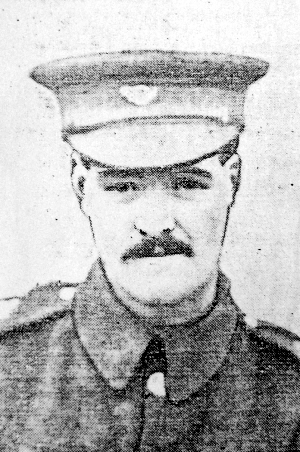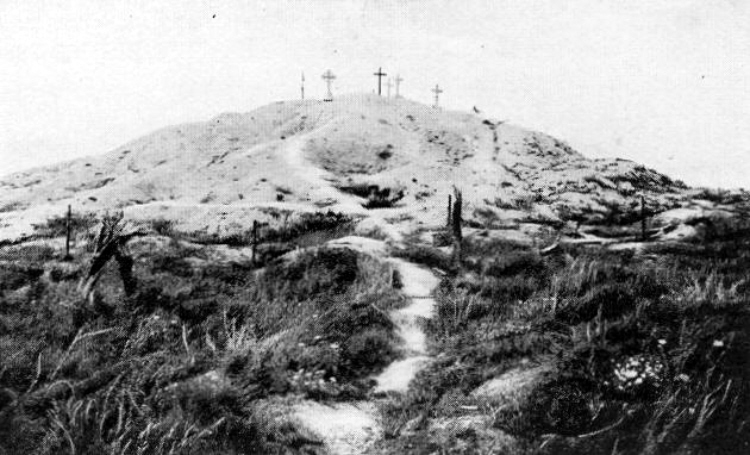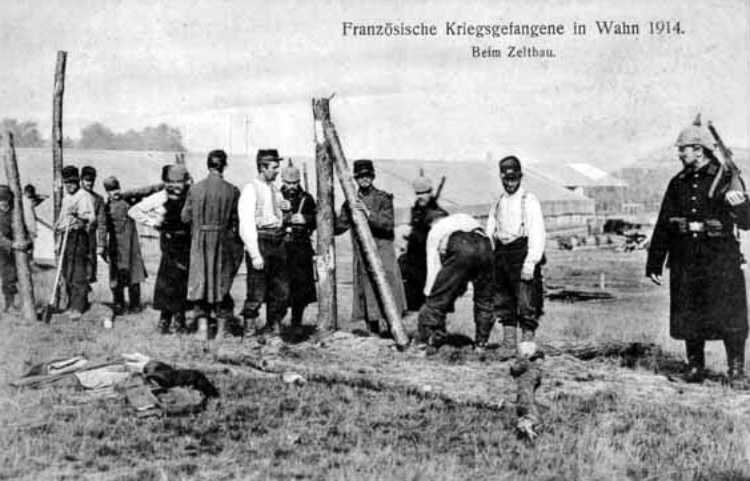
Percival Leopold Spurr, known as ‘Percy’, was born in Earlsheaton in late 1889, the second child and second son of Alfred Spurr and his wife, Mary Ann (nee Brearey), who married at Dewsbury All Saints Church on the 25th October 1884. The couple had ten children from their marriage, but sadly three died before April 1911.
In 1891 Alfred Spurr and his family, including Percival, were living at Wakefield Road, Chickenley Heath and they had a Wakefield Road address in 1901 when they lived next door to the Spinners Arms. In 1911, Alfred Spurr, a Prudential insurance agent, his wife Mary Ann and six of their children, including Percival, now working as a tram conductor, were living in a five-roomed house at 142, Dewsbury Road, Street Side, Ossett.
On the 26th September 1913 at Dewsbury Registry Office, Percy Spurr married Annie Tunney and they went to have they had three children: Nora Spurr, born on the 10th April 1914, Alfred Spurr, born on the 28th August 1916 and Douglas Spurr born Summer 1920.
Percy Spurr, a colliery banksman, of 11, Chancery Lane, Ossett, was called up and enlisted at Ossett on the 18th November 1916. He was 26 years and 2 months old and he had previously served in the King’s Own Yorkshire Light Infantry, but he had been discharged after 2 days due to defective eyesight. Percy was 5’ 6¼” tall with a chest measurement of 36½”. He gave the name and address of his wife, Annie Spurr, of 11, Chancery Lane, Ossett as his next-of-kin.
Percy Spurr was posted to army reserve until the 15th June 1916, when he was mobilised, and posted to the 11th Battalion of the King’s Own Yorkshire Light Infantry. On the 1st September 1916, Percy was attached to the Training Reserve Battalion and then posted to the 3rd Battalion of the Northumberland Fusiliers on the 6th October 1916 with the service number 42327. He embarked for France the following day. Shortly after disembarking Private Spurr was transferred to the 1/8th Battalion, Durham Light Infantry with the service number 6082. However, in early 1917 soldiers with four digit service numbers were issued with a new six digit numbers. In Percy’s case this was 301949.
The 1st/8th Battalion of the Durham Light Infantry was formed in August 1914 at Bishop Auckland as part of DLI Brigade, Northumbrian Division. They moved to Bolden Colliery in early August, then to Ravensworth Park and were at Newcastle by October 1914. On the 17th April 1915, the Battalion landed at Boulogne and on the 14 May 1915 they joined 151st Brigade in the 50th (Northumbrian) Division. On the 3rd June 1915, after taking heavy casualties, 1/6th and 1/8th Battalions merged to form the 6/8th Battalion. After reinforcements, they resumed their original identities on the 11th August 1915. On the 15 July 1918, the Battalion was reduced to cadre strength and transferred to Lines of Communication, then on the 16 August 1918, they transferred to 117th Brigade in 39th Division and on the 6th November 1918, the Battalion was disbanded in France.
On the 5th November 1916, three Battalions of the 151st Infantry Brigade were to assault the Butte de Warlencourt, a 50ft high prehistoric burial mound in the centre of a man-made swamp, near the village of Warlencourt on the Somme battlefield, and used as an observation point by the Germans. It was heavily fortified with barbed wire, machine guns, tunnels and mortars. The British Army tried to capture it several times in the Autumn of 1916; the first attack was on 1 October by the 141st Brigade of the British 47th (1/2nd London Division).
Each Battalion being on a frontage of three Companies with one Company in reserve which was to remain in Maxwell Trench. The 9th D.L.I. was on the left, the 6th D.L.I. in the centre, and the 8th D.L.I. on the right. At 9 a.m. the assaulting Infantry moved forward. These troops were in four lines with a distance of 15 yards between each line. The 6th D.L.I. and 8th D.L.I. when they had gone forward about 50 yards came under very heavy machine gun fire, which caused them many casualties and prevented them from reaching their objectives although many heroic efforts to get forward were made.
Private Percy L. Spurr was reported killed in action on 5th November 1916. On 12th November, his wife and parents were notified accordingly, a War Office Casualty List included his name and the “Ossett Observer” 1 reported his death in the usual way:
“Gawthorpe Soldier Gives His Life – Only Called Up In July – Another Ossett soldier who has laid down his life in his country’s cause is Private Percy Spurr (27), of the Durham Light Infantry, who prior to joining the forces resided with his wife in Chancery-lane, Gawthorpe. It was about the middle of July that he answered the call to arms, and his death in action on the western front is reported to have taken place on November 5th. At the time he joined up he was employed at Shaw Cross Colliery, but formerly he was employed as a conductor on the Ossett and Dewsbury tramcars. He was a respected attender at the Dewsbury-road Primitive Methodist Church, where he had also been a Sunday school teacher. He was the son of Mr. Alfred Spurr, insurance agent, of Dewsbury-road.”

Above: The Butte de Warlencourt shortly after the war ended. The Butte marked the very limit of the British advance on the Somme and King George V visited the Butte in July 1917.
On the 21st December 1916, his parents who were living at at 142, Street Side, Ossett received a postcard from Germany and Percy’s father, Alfred, subsequently made contact with the Infantry Office at Clifton, York.
All that remains of that communication is a very poor copy but the following words are clear. Alfred writes:
“……..on 21st December ’16 we received a Post Card…and I am quite sure is in his hand …I am sending you exact copy”
“Dear wife & all just a line to say I am in ….hoping you are the same and I …happy and well. Well, I was taken prisoner…don’t you worry …Annie…..”
“We are all quite sure it is my son’s hand writing. We received this Post Card Dec 21st. I am now writing to ask you your opinion – I am quite sure he is………….am do anything… You will see the date on the Post Card…. and he also says he …prisoner on 5th November. This is the date you say he ………. “
The Army sought clarification including requesting sight of the original post card. Alfred sent this to them at Clifton, York with the following cover later dated 13th February 1917:
“Dear Sir, Just received your wire re 6082 Pte Percy Spurr. Enclosed I forward P.C. received from Germany. Am sending it in a registered letter. You will quite understand we would not on any account have it lost. Your wire has given us all new life – Am sure you will trace him. It is very good of you to wire, and I am sure you will let us know as soon as you have any news, and forward the P.C. back here as soon as you have done with it. Don’t misplace it on any account. It is very hard parting with it I can tell you. Thanking you again, Yrs truly Alfred Spurr”
On sight of the postcard, the army wheels went into motion. On the 20th February 1917, the Clifton office informed the War Office that they had seen the postcard from Percy and instructed that the report of his death on Casualty List C 1018 be cancelled adding that the stamp on the post card read: “Absendung 30 11 1916 P. Pr. Str. Wahn” i.e. sent on the 30th November 1916. Wahn was a German POW Camp, near Cologne, and was considered to be a “good” camp.
On the 27th February 1917, Clifton Infantry Dept. at York wrote to Percy’s wife, Annie Spurr c/o 142 Street Side, Ossett:
“Dear Madam, A report has now been published by the War Office that your husband No, 6082 Pte. Percy Spurr 1/8th Bn D.L. Infantry is a Prisoner of War in Germany. This report is based on the evidence in the attached communication which you received from Germany. I very much regret that his name has not yet appeared in a list of Prisoners received from the German Government. I am consequently unable to inform you of his place of detention. Yours etc. Clifton, York, 27.2.1917”
It was now official. Percy Spurr was not dead after all, but a prisoner of war in Germany. He would have been a prisoner of war between the 5th November 1916 and the 11th November 1918. His army service record indicates that he was in France until the 19th December 1918 and he returned home the following day.
The “Ossett Observer” 2 had a report about Percy Spurr’s incarceration as a prisoner of war in Germany:
“News Of Soldier Previously Reported Killed – Gawthorpe Man A Prisoner In Germany – A month ago it was reported that Private Percy Spurr, a Gawthorpe soldier, had been killed in action. This week, however, his family have had the gratification of receiving a message from him, in his own handwriting, stating that he is quite well, but a prisoner in the hands of the Germans. In the course of the communication, which was addressed to his wife, Private Spurr says that he was taken prisoner on the Somme on November 5th, and was not wounded. He concludes: ‘Don’t you worry yourself, as I am alright. I have not got to my destination yet, but as soon as I get a chance to send my address I will do so’.
Private Spurr, who is the son of Mr. Alfred Spurr, insurance agent, Dewsbury-road, was in the Durham Light Infantry, and before enlisting lived in Chancery-lane, Gawthorpe. The report of his death a month ago was by circumstantial account from an officer, so that the news to hand this week, after all hope had been given up, was a complete surprise to his family.”

Above: French prisoners in the Wahn prisoner of war camp in 1914. Private Percy Spurr was held here for a while in 1916.
Percy had survived army service and two years in a German P.O.W. Camp, but his experiences had caused him physical and mental damage. He was discharged on the grounds of general debility on the 21st March 1919. From that date he was awarded a weekly pension of 11/- and an allowance of 4/8d a week for his two children, both to be reviewed after 26 weeks. His third child, Douglas, was not born until after he died in 1920.
On the 30th December 1919, Crawshaw & Warburton Ltd, colliery proprietors, with collieries at Shaw Cross, Chidswell, Ridings and Savile & Soothill, wrote to the Army. The company indicated their willingness to re-employ Percy, on his release from the Army. Percy had worked for the company between April 1915 and July 1916. In spite of his discharge on medical grounds, it appears that Percy was still transferred to Army ‘Z’ Reserve until the 31st March 1920.
‘Z’ Reserve was established due to fears that Germany would not accept the terms of any peace treaty, and therefore the British Government decided it would be wise to be able to quickly recall trained men if there was a resumption of hostilities. Soldiers who were being demobilised, particularly those who had agreed to serve ‘for the duration’, were at first posted to Class Z. They returned to civilian life, but with an obligation to return if called upon. The Z Reserve was eventually abolished on the 31st March 1920.
Percival Leopold Spurr of 1, White’s Buildings, Dewsbury Road, Ossett died on the 19th May 1920 and was buried on the 22nd May 1920 at Ossett Holy Trinity Church in a family grave which may be unmarked. At the time of his death, his wife, Annie was heavily pregnant with their third child and Douglas P. Spurr, was born later in the Summer of 1920. The death certificate records Percival as being of 1, White’s Buildings but his wife’s pregnancy may be the reason why his final moments were with his father, Alfred Spurr, at his home at 142 Dewsbury Road.
In November 1920, the Ministry of Pensions informed Annie Spurr that she and two of her children were entitled to a pension. Her third child would not qualify on the basis that he was not born while Percy was in army service. By January 1922 Annie was recorded living at 3, Palmers Buildings, Cutsyke, Castleford, but by December 1925 she had returned to live at White’s Buildings, Dewsbury Road, Ossett. She was, by then, in receipt of a weekly pension of 26/8d for her and 17/6 for two of her three children. It is not known if Annie Spurr remarried.
Private Percival Leopold Spurr was posthumously awarded the British and Victory medals. Because he did not serve overseas before the 31st December 1915 he did not qualify for the 1914/15 Star. Neither is there a Commonwealth War Grave established for him but he is remembered on the 1928 Commemoration Programme for the Unveiling and Dedication of the Ossett War Memorial. He is also remembered on the Gawthorpe St Mary’s Church Roll of Honour which, since the demolition of the church, is lodged with Holy Trinity church for safe keeping. Since 11th November 2018 Percival is also remembered by his name at the Ossett War Memorial in the Market Place.
Percival L. Spurr, aged 30 years, son of Mr. Alfred Spurr of 142, Street Side, Ossett and the husband of Annie Spurr, 1, White’s Buildings, Dewsbury Road, Ossett died on the 19th May 1920. He is buried was buried at the Ossett (Holy Trinity) Churchyard, 1 Church Street, Ossett on the 22nd May 1920.
The Commonwealth War Graves Commission (CWGC) did not commemorate Percival Spurr probably because his death occurred after the end of the war, after his discharge from the army and because he died of a disease, valvular disease of the heart (aortic) and nephritis. Recent evidence revealed that this disease may, in some circumstances, be attributed to his service and as a consequence in January 2021 an application was made to CWGC seeking his commemoration. A full response is awaited (October 2021).
Biography updated for Ossett Heritage in October 2021.
References:
1. “Ossett Observer”, 18th November 1916
2. “Ossett Observer”, 23rd December 1916